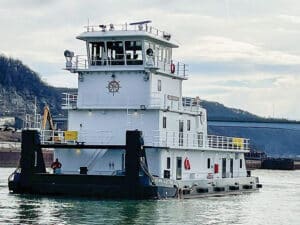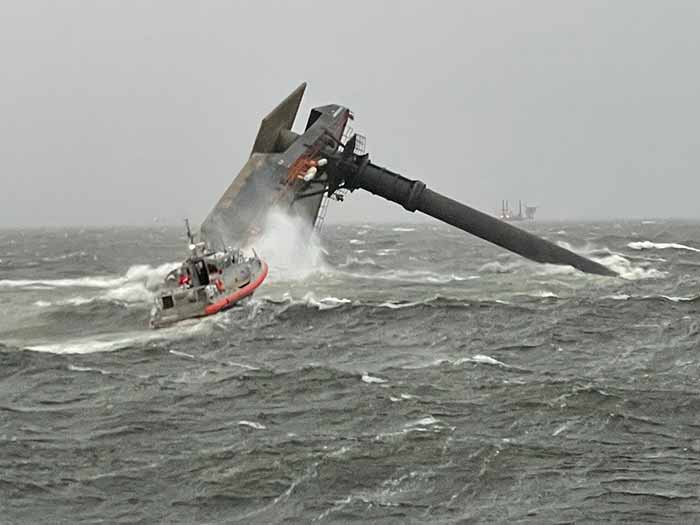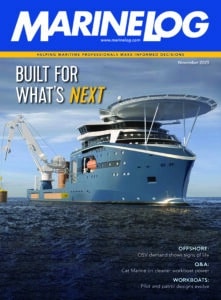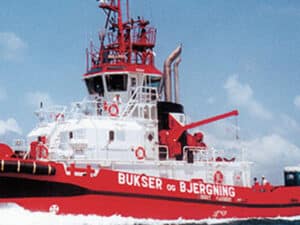
Op-Ed: The impact of climate change on shipping
Written by
Capsized SEACOR Power on the evening of the accident, with a Coast Guard response boat in the foreground. [U.S. Coast Guard photograph]
By Roberta Weisbrod, Executive Director, Worldwide Ferry Safety Association
Ocean workers are on the front line of climate change, the Lloyd’s Register Foundation (LRF) concludes based on a massive survey conducted with the Gallup Organization of workers in a range of fields. The survey, of 147,000 workers in 42 nations in all fields, found that ocean workers had a heightened perception of risk compared to other workers (50% were very worried compared to 37% of all other workers). More to the point based on the actual harm experienced, “one third (33%) of ocean workers reported having personally experienced serious harm from severe weather in the last two years, compared to 20% of other workers.”
One solution with dealing with this risk, LRF rightly contends, is better occupational training to deal with sudden hazardous weather at sea. Another approach, advanced in this article, is to address the need to vastly improve maritime weather predictions and communications so that ocean workers have adequate warning.
“For every degree Celsius that Earth’s atmospheric temperature rises, the amount of water vapor in the atmosphere can increase by about 7%,” reports NASA. Climate change impacts on land have been very obvious in this and recent years, with whack-a-mole flash floods in many parts of the U.S., Europe, Asia, and Africa as the warm saturated air dumps its load of water inland at unpredictable times and amounts.
On the ocean, the heat of the atmosphere has raised sea surface temperature. For mariners this results in changes in ocean circulation and more frequent, sudden severe storms. Impacts vary from loss of containers to vessels capsizing. To understand and be able to predict how this big picture of climate change translates into impacts on vessels in an ocean location at a particular time—requires data.
As an example, severe winds during a thunderstorm led to a loss of stability and ultimately the capsizing of the liftboat SEACOR Power, the National Transportation Safety Board said in 2022 during a public board meeting. Of the 19 people aboard the vessel, six died and seven are missing, presumed dead. Six people were rescued by the U.S. Coast Guard and other vessels. The SEACOR Power, valued at $25 million, was a total loss.
“We have 15 times less data from ships than data from weather stations over land and the ocean is twice as big as the land”, says Florence Rabier, director general of the European Centre for Medium-Range Weather Forecasts, a research institute engaged in producing global forecasts.
To address this deficit, OceanOPS, a branch of the World Meteorological Organization and the international Ship Observation Team launched a bold but realistic, and well-thought-out initiative, “10,000 ships for the Ocean” that enlists ocean-going vessels to be outfitted with instruments that will make direct observation about the weather and ocean. The equipment will be automated, standardized, maintained, and verifiably calibrated. Early adopters will have the opportunity to impact the framework, the network and instruments design.
Although the initiative was launched less than two months ago, there are already early adopters. Nearly 500 ships have already been pledged, including from MSC, Maersk, SMT, Höegh Autoliners, Brittany Ferries, and Alcatel Submarine Networks. Yes, there is a cost for the equipment and 5-year servicing package of a total of $10,000—or about $5 per day.
All fleet and vessel owners and operators are encouraged to join for their own and the greater good what is being called the Fleet of the Future. As Mathieu Belbeoch, project manager, says, “Please help us and put some sensors on ships and the data will flow”
Given the continuing and unprecedented changes in maritime weather please enhance your safety and join here.




![The new Prestige-class vessel will be a sister ship to Seven Seas Prestige, set for delivery in 2026. A second ship in the same class is already scheduled for delivery in 2030. [Image: Regent Seven Seas Cruises]](https://www.marinelog.com/wp-content/uploads/2025/11/sevenseaspresttige-300x225.jpg)